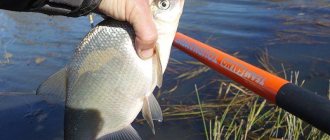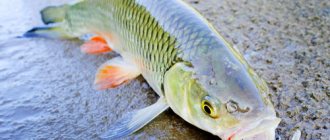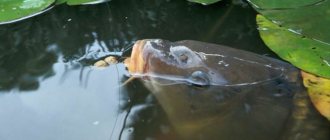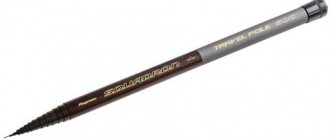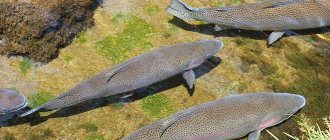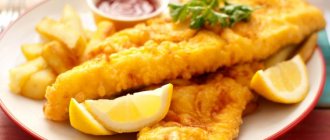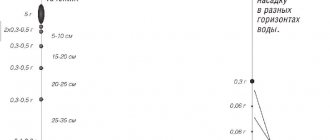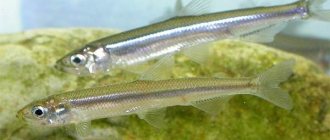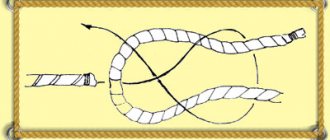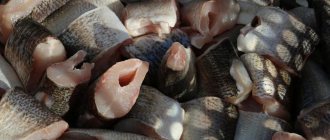At the dawn of the development of gear for “long casting” in the construction of float equipment, there were many experiments on the use of sliding floats with two attachment points on the fishing line. As a result, it turned out that this was inconvenient and unnecessary.
With two-point floats, it's all too common for the rig to get caught in flight and, worse, it's almost impossible to get the line between the float and the rod. But the floats remain and are successfully used in Bolognese gear. However, there is still a good example of their effective use.
Let's imagine that we are at the Volga reservoir on a day off. Due to the reduction in water discharge from hydroelectric dams, the current becomes weaker and weaker, and at some point the movement of water almost stops.
At the same time, the level decreases, and the fish move away from the shore. The casting range becomes unattainable for the feeder, so a boat is needed. In most cases, fishing from a boat is now done using the same feeder, onboard fishing rods, and also using time-tested variations of “rings” and “springs.”
But when the current is very weak, it is necessary to cast at least some distance from the boat. If you lower the bottom equipment vertically, then twisting of the leads is inevitable. You can, of course, make equipment that is devoid of this drawback, for example, with an end weight, but there is another problem.
In a weak current, the bait is washed out of the feeder very slowly, and you can wait for the fish to arrive until Monday. Based on these conditions, you need to make the bait light, and the tackle so as to increase the fishing area.
There is another important factor - the bites are “weak”, and the sensitivity of the onboard gear may not be enough. And if the water is rough and the boat is rocking, then fishing will become completely ineffective. Exit in float equipment.
Since the fishing depth is decent, you will definitely need a sliding float. I believe that even with a depth of 6 m there is no point in straining with a long fly rod and stationary equipment.
Coil
The most inconvenient of the reels are the spinning reels, although you can also fish with them. The same applies to cartoonists. Inertial models with a large drum in this case do not have such obvious advantages as in fairly strong currents.
In our case, the current can be so weak that the equipment will not pull the line even from a very good reel. In any case, the line has to be released from the reel with your free hand. The inertial reel is good because it guarantees fast and, most importantly, hard hooking.
What to go with
The main tackle on the riffle is a Bolognese fishing rod (photo 3) . No other float tackle allows you to present bait to the fish in strong currents and shallow depths as successfully as a “lap dog” can do. When choosing a rod for “roll” fishing, I would advise you to pay attention not only to its length (which usually ranges from 5 to 7 m), but also to its power. Both bait and fishing conditions on the rifts can be very different.
So it’s better to choose a rod with a good power reserve (test up to 25 - 30 g). With such a rod you can catch ides with steamed peas, and try to tempt bream to bite by offering it a retrieve with a strong hold on the rig. I myself have been using a Royal Rods Vivalto with a length of 6 m and a test weight of up to 20 g for several seasons now. Perhaps this rod is not as “polished” in design as the Maver , but my feedback from working with them is only positive.
Sliding floats for long casting
The basis of the design of the equipment is a sliding float with two attachment points on the fishing line. In my opinion, there is no point in paying attention to the difference in the body shape of such floats. If the current is weak, then manipulations with the equipment, and this is mainly either slowing down the swim, up to a complete stop at some point, or twitching and pulling towards you, do not lead to a loss of stability of the float. It is important to load it correctly.
Personally, I began to use the floats of one, now well-known Italian one. This manufacturer has floats with two attachment points on the line in only three shapes, and I do not see any difference in their functionality (pictured). Who likes which one?
In my opinion, it is good that the antennas have their own buoyancy. It is always good when a set of baits that differ in weight is used in the fishing process. Initially, the float is loaded so that the entire body and even part of the antenna are under water.
When changing a light bait to a heavier one, the float will sink lower, but not sink, thanks to the buoyancy of the antenna. Of course, it happens that dragging a worm along the bottom or even anchoring a rig with bait on a hook leads to flooding of the float.
In such cases, the easiest way is to remove one of the lightest weights from the rig. The distribution of the load is carried out according to the simplest scheme - one main sinker and a sub-weight, divided into three or four parts. This design is optimal based on the set of wiring that is usually used.
Since the fishing depth is large, I advise using a stationary olive as the main sinker. It is a stationary one, which is fixed on the fishing line with two silicone cambrics. The sliding olive in this case is worse, since it requires more complex fixation, and the current is very weak and there is no twisting of the line during the swim. I use tungsten alloy olives from the same company. Unlike lead olive, tungsten sinks equipment much faster, which can be critical.
Equipment installation options
If the carrying capacity of the float does not meet the specified conditions (type of bait, current strength, depth, wind), cautious large fish are unlikely to dare to try the bait on the hook. However, when choosing a float, you should pay attention not only to its carrying capacity, but also to the shape of the body. For fishing on riffles, floats with a body in the shape of a ball or an olive have proven themselves better than others. I chose the Expert Professional series . These are inexpensive, but very well made and easy to use floats (photo 5) .
I divide all rigs for currents into two large classes: rigs for fishing with steamed grains (photo 6) and rigs for fishing with baits of animal origin. They differ not only in weight, but also in the arrangement of the weights on the fishing line.
For successful fishing with steamed grains, the total weight of the equipment should be minimal. A gram is one and a half maximum. My experience and the practice of my friends suggests that the indicated weight of equipment is quite enough for catching fish even in the fastest currents. For myself, I choose the weight of equipment as follows: if you have to fish on a sandy bottom and a uniform current, equipment with a float with a carrying capacity of 1 g is quite enough, and under more difficult fishing conditions (side wind, uneven current) you can put a float of 1.2, maximum 1.5 g.
Experiments with increasing the weight of the equipment to 2.5 g immediately had a negative impact on the number of bites. The load must be distributed along the line so that it consists of at least three parts. Since this task (dividing one gram into three or more parts) is not easy, two weights (which is about 80% of the total weight of the load) are driven almost under the float. The smallest weight - the “podpasok” - is placed directly next to the hook. Leash - no more than 20 centimeters! And here’s why: the fish tries the bait moving in the water column very carefully, so with a long leash you may not even see a bite.
But for the presentation of baits of animal origin (worms, maggots, broken shells, etc.), heavier equipment (2.5 - 10 g) has proven itself better than others. This type of bait must not only be presented at the very bottom, but also often with a strong hold so that it moves much slower than the current. The most successful was the load, which consisted of one large sinker, an “olive” and a “pod” that slid freely along the fishing line (photo 7) . The leash must be long - 50 - 70 cm.
On riffles with fast currents, I use flat Cralusso Bolo (photo . If you have some skill, this float can be a big help when you need to bring the bait directly to the very shelter of the fish or hold it above the balls of bait lying on the bottom.
. If you have some skill, this float can be a big help when you need to bring the bait directly to the very shelter of the fish or hold it above the balls of bait lying on the bottom.
Tackle
It is quite difficult to give specific advice in advance regarding the thickness of the fishing line. The thinner the line, the closer to the vertical it will be possible to lower the bait to the starting point of the retrieve.
This is very important if bait is used. Often, almost all bites occur at a distance of up to a meter from the bait lying on the bottom. I use a main line no thicker than 0.14 mm, and for a leash I take 0.09-0.11. The exception is when a carp approaches - here you have to change all the equipment.
The hook is selected according to the size of the bait, but unlike rigs for a fly rod or plug, the hook size is slightly larger. A very important parameter is the hook’s own weight, especially if wiring with braking the passage of the equipment or with holding it in place is used.
Such wiring is effective when fishing for roach and silver bream. But the main object is usually bream, and here the fishing technique is simpler. You can fish according to the “walking” donkey principle, that is, survey a large area in search of active fish. No bait is required, so fishing is very active, with exploration of various depths and places with interesting terrain.
An echo sounder helps here. After detecting active fish, you can stand on the spot, feed and continue fishing. When hunting for bream, this tactic is completely justified. You can immediately decide on a fishing spot, set the boat in a stretch on two anchors and start feeding.
Choosing the appropriate fishing line diameter
The use of lines of certain diameters in float fishing is both a necessity and a personal whim; there is no better option for everyone.
Take the main line in match fishing, where the range of diameters is very large, from 0.14 to 0.23 mm. Moreover, the specific choice has nothing to do with the size of the fish being caught, because with the main 0.14 mm and a slightly thinner leash, any bream can be caught without any problems, thanks to the spinning rod and the rod. But each fisherman has his own opinion on the appropriate diameter of the main fishing line, which affects the range, accuracy, the likelihood of overlap, and even the safety of the equipment. Some people use fairly thick fishing lines, about 0.22 mm, assuring that with them the risk of entanglement is minimized due to the increased rigidity of the thick fishing line, which acts as a kind of anti-entanglement agent for the leash. Many people use some kind of average version of the main line, around 0.18 - 0.20 mm, and for me these diameters work, and they don’t cause tangles. And someone develops their fishing with thin main lines, 0.14-0.16 mm, believing that the thinner, the better the casting in terms of distance and accuracy, and the smaller the float can be used without losing anything in casting. Moreover, this position applies to fishing with both the lightest match floats and the heaviest ones at ultra-long distances, under 40-50 m. And in order to reduce the load on thin main lines when power casting with heavy floats, avoiding breakages, a strong shock leader is also introduced into the equipment, as is done in carp bottom fishing or in a heavy feeder.
And in leashes, whether in fly fishing or in match fishing with a float, there is a very serious range of diameters. I have the thinnest leader line 0.08 mm, some people use thinner ones. And the maximum is 0.14 mm - there is no point in a thicker one, because even a bream weighing 2-3 kg is enough for a 0.12 mm leader. Well, the most popular option for roach, bream and other “average fish” is around 0.10 mm, especially in summer. For cold water I can set it to 0.07 mm, sometimes it helps.
In any case, everyone has their own opinion on the optimal diameter of the leash, taking into account their own tackle, their own fishing skills - it’s stupid to put everyone under the same brush.
Groundbait and supplementary feeding
Since the current weakly erodes the bait, I use a large “winter” feeder, with the help of which I deliver a “light” mixture to the point where the equipment begins to swim. It makes sense to lower the feeder using a short, powerful rod and reel. In this case, it will be convenient to lower the equipment not at the very side of the boat, but at some distance.
To get started, about a kilogram of dry bait is enough. I add a little chopped worm and a handful of maggots to it. It’s good to add another handful of millet porridge, which will hold the bream when it approaches the bait. You can initially deliver more food to the bottom, but only if it is assumed that the current will intensify over time.
Fishing in the wire
As for the wiring technique itself, in most cases the bait is dragged along the bottom. If the bites are rare and occur at the same point, it makes sense to try to anchor the equipment at this point with a pod. It is for this purpose that I divide the under-grazing into several parts, in order to be able to reduce or increase the part that lies at the bottom. Holding the rig at the bite point can be very effective, but in this case I advise you to increase the length of the leash. The length is selected each time experimentally and can reach one and a half meters. With a long leash, guiding is good with periodic stops of swimming and letting go into free swimming.
It makes sense to experiment with wiring and equipment design not only before the bites start, but also when they become rare.
As for baits, for example, on the Volga I almost always use a worm. Other baits, such as maggots, dough or “pasta,” bring success much less often, although you should try.
The fishing being discussed is very interesting, especially on cool days of weak currents, calm weather and summer heat. This method is good wherever the current is weak and the depth is large.
General principles of float fishing
Before float fishing, a promising place is selected, which is densely baited at one point. The bait should be thrown into the water in small portions - balls.
For catching small and medium-sized fish, it is better to use dark bait, and for large ones, light (contrasting) bait.
The distance from the float to the hook in the rig is set depending on the depth of the reservoir and the expected location of the fish in the water column.
As with other fishing methods, you need to constantly experiment with baits, scents, and also try and experiment with the distance of the bait from the bottom.
Author of the article: Vitaly Leonidovich Ivanov, 2021.
